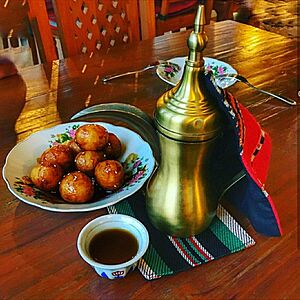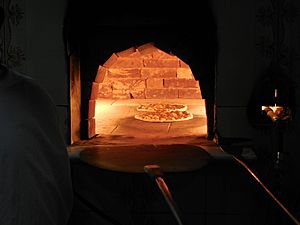Emirati cuisine facts for kids
```wikitext

Emirati cuisine (Arabic: المطبخ الإماراتي) is the traditional food of the United Arab Emirates (UAE). It is part of the wider Eastern Arabian cuisine. This means it shares many similarities with food from nearby countries like Omani cuisine and Saudi Arabian cuisine. It also has influences from other Middle Eastern and Asian foods.
Today, the United Arab Emirates is a big international hub. This means you can find many different types of food from all over the world there.
Contents
A Look Back: History of Emirati Food
How Emirati Food Began
People in the UAE region started growing date palms a very long time ago, around 2500 BC. This time is known as the Umm Al Nar period. Many date seeds have been found at old sites from this time.
Archaeologists have also found grinding stones and clay ovens. This shows that people were processing grains to make food. Studies of ancient human teeth from this period suggest people ate a lot of dry bread.
Modern Emirati Food History
The food we know as Emirati cuisine today comes from the Trucial States. This was the name for the area before it became the UAE. Its food is similar to other Arabic and Middle Eastern dishes found across the Arabian Peninsula.
Emirati food is a mix of different lifestyles:
- Bedouin diet: This included meat and camel milk.
- Fishermen's diet: This mainly featured fish from the Persian Gulf.
- Farmer's diet: This mostly consisted of dates.
These diets, along with spices like cinnamon, saffron, and turmeric, created the base for traditional Emirati dishes.
Traditional Emirati food uses a lot of meat, grain, and dairy. Vegetables that grow easily in good soil, like cucumbers and tomatoes, are also very common. Dried lemons, called loomi, are grown locally and used in many dishes. Mangos are also grown, especially in northern areas like Masafi.
The meats traditionally eaten include chicken or small birds like Houbara bustards, and goats. Camel meat is usually saved for very special occasions. This is because camels are highly valued for their milk and for carrying things.
Many dishes are like stews, cooked in one pot. Saffron, cardamom, turmeric, and thyme are key flavors in Emirati cooking. Rice became part of the diet when traders came to the region. Leaves from local trees, like the Ghaff tree, were sometimes used to stuff small birds for extra flavor.
Some traditional main dishes are Maq'louba, Margooga, Harees, Machbous, Frsee'ah, Fireed, Jisheid, and Mishwy.
For Breakfast, Emiratis often eat breads like raqaq, khameer, and chebab. These are served with cheese, date syrup, or eggs. These breads were traditionally made on a curved hot plate, like the ones Bedouins would have used. Balaleat is another breakfast dish, which became popular after traders introduced pasta.
Sweet treats include luqeymat. These are deep-fried balls of pancake batter rolled in sesame seeds and drizzled with date honey. Other desserts are khabeesa, made from flour bread crumbs mixed with sugar, cardamom, and saffron. There is also bethitha, which is semolina mixed with crushed dates, cardamom, and clarified butter.
After a meal, it is common to serve a red tea with mint to help with digestion. Another tradition is to welcome guests with dates and gahwah (Arabic coffee). These are offered when guests arrive and are available throughout their visit.
Sometimes, Levantine cuisine (food from countries like Lebanon or Syria) is confused with Emirati food. Dishes like shawarma, hummous, tabbouleh, and mixed grill are newer additions to the Emirati diet.
Popular Emirati Foods and Dishes
Seafood has been a main part of the Emirati diet for hundreds of years. The food of the UAE shows its Arabian roots and how it has been influenced by other cultures over time. Since eating pork is not allowed in Muslim law, it is not found in most menus. Hotels often offer pork substitutes like beef, chicken, or veal sausages for breakfast. If pork is available, it is always clearly marked.
Meat, fish, and rice are the main foods in Emirati cooking. Lamb and mutton are preferred meats over goat, beef, and camel meat. Dates are usually eaten with meals.
Popular drinks include coffee and tea. These can have cardamom, saffron, or mint added for a special flavor.
Some supermarkets might sell pork in a separate section.
Here are some dishes that are part of Emirati cuisine:
- Asida
- Al Jabab bread
- Bathieth
- Harees
- Jami
- Jasheed
- Kabsa
- Khabees
- Khanfroush
- Khamir Bread
- Machboos
- Madroob
- Markouka
- Maqluba
- Muhala bread
- Quzi
- Salona
- Tharid
- Waggafi bread
Drinks in Emirati Culture
- Camel milk
- Soft drinks
- Tea
- Water
- Juice
- Laban (a type of yogurt drink)
- Arabic coffee
- Arabic tea
Food Events
Dubai Food Festival
The first Dubai Food Festival took place from February 21 to March 15, 2014. This event aimed to show off Dubai as a major food city in the region. The festival featured foods from over 200 different countries. It was a great way to explore many different flavors and cuisines available in Dubai.
See also
 In Spanish: Gastronomía de los Emiratos Árabes Unidos para niños ```
In Spanish: Gastronomía de los Emiratos Árabes Unidos para niños ```



